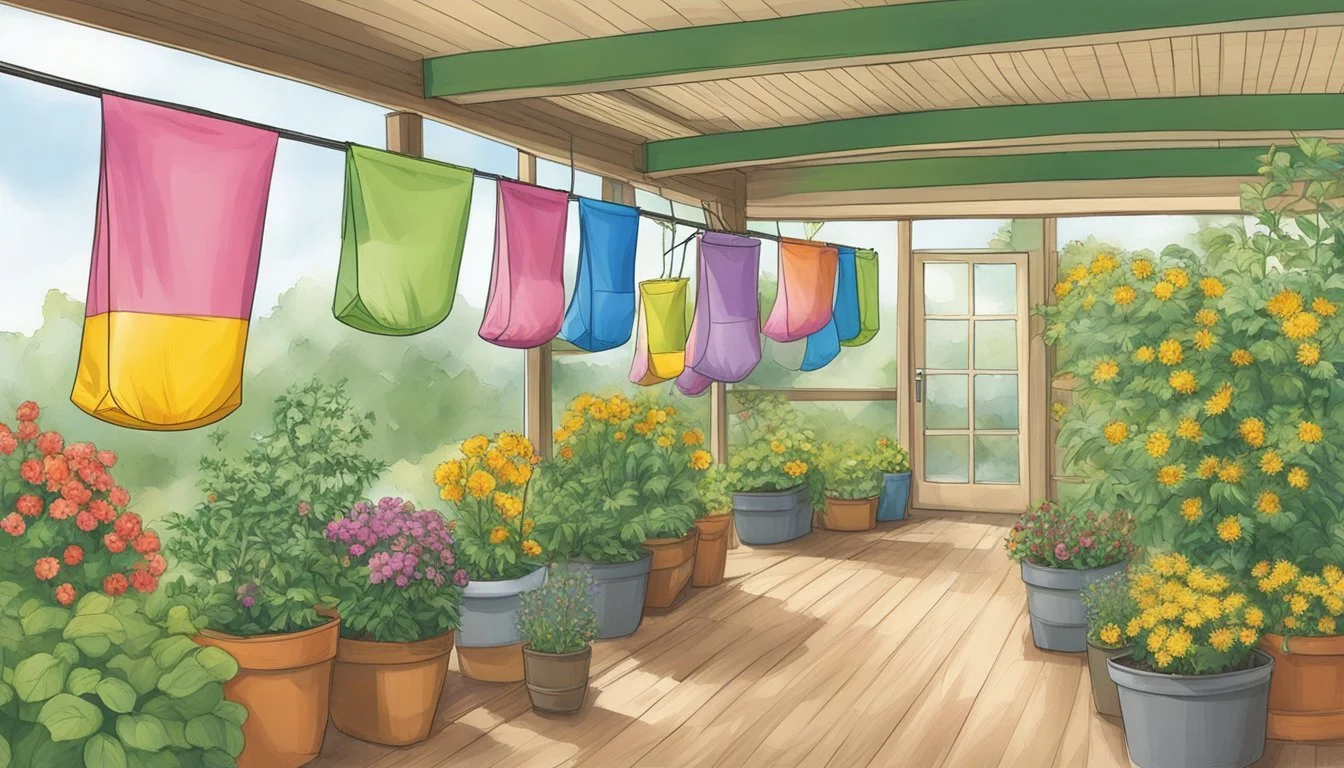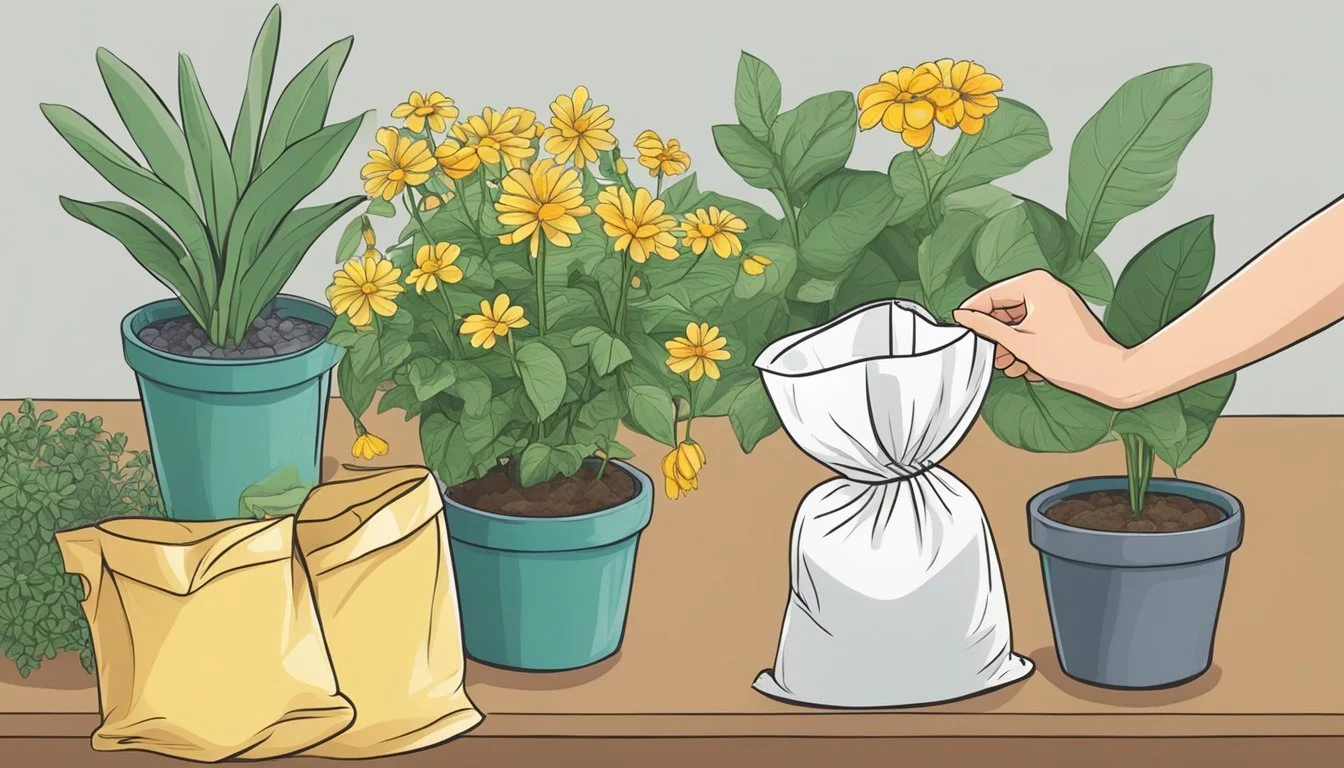The Ultimate Guide to Using Pollination Bags
Boosting Home Garden Seed Yield and Purity
In the world of plant breeding and seed production, pollination bags are indispensable tools for homesteaders aiming to maintain the purity of plant genetics and increase the efficiency of their breeding programs. These specialized bags prevent cross-pollination, ensuring that plants reproduce only with the desired pollen, which is particularly critical for developing hybrid seeds. By controlling pollination, growers can predict and enhance crop traits, improve yields, and tailor plants to better suit their environmental conditions or personal preferences.
Pollination bags are designed to fit over the flowers or inflorescences of plants, blocking unwanted pollen from wind or insect vectors and allowing for the selective introduction of desired pollen. This meticulous process enables homesteaders to capitalize on the genetic potential of their plants, producing offspring with the most advantageous traits. Through the use of these bags, even the smallest-scale breeders can achieve results that were once the domain of professional agricultural scientists.
With the ultimate guide to using pollination bags, homesteaders can step confidently into enhanced plant breeding and seed production practices. This resource provides an in-depth look at the methods and benefits of strategic pollination, offering clear, comprehensive instructions. From selecting appropriate pollination bags to the timing and methods of manual pollination, the guide empowers growers to maximize the effectiveness of their breeding efforts and achieve the best possible outcomes for their plant and seed projects.
Understanding Pollination and Its Significance in Seed Production
Pollination is a critical process for plant reproduction and seed production in homesteading, influencing both the quantity and genetic quality of crops. Effective pollination strategies can significantly enhance breeding programs and yield potentials.
Basics of Pollination
Pollination involves the transfer of pollen grains from the male part of a flower, the anther, to the female part, called the stigma. Genes within the pollen are then able to fertilize the ovule, leading to the development of seeds that carry genetic information from both parent plants. This genetic combination determines the resulting plant's genotype.
Role of Pollinators in Agriculture
Pollinators, which include insects, birds, and wind, facilitate the movement of pollen. Insect pollination is especially vital in agriculture, as many crops depend on insect species for successful plant reproduction. Pollinator visitation can not only enhance the yield but also improve the quality and stability of the crop population.
Different Pollination Strategies: Cross-Pollination Vs. Self-Pollination
Cross-pollination occurs when pollen from one plant fertilizes another plant of the same species, promoting genetic diversity and adaptation. This can result in hybrid plants that combine desirable traits from two different parent genotypes.
In contrast, self-pollination happens when a plant fertilizes itself, a common strategy in many plants that leads to less genetic variation.
Pollination Control Techniques
Pollination control is essential in breeding programs to ensure the desired cross or maintain a pure strain:
Pollination bags can be used to prevent unwanted pollinator visitation, thereby controlling which plants contribute genetic material for seed production.
Strategically timed pollinator visitation can be manipulated to enhance cross-pollination or to produce hybrid seeds with specific traits.
Advantages of Using Pollination Bags in Breeding Programs
Pollination bags offer significant benefits in controlled breeding programs by enhancing seed quantity and quality, ensuring genetic control, and preventing genetic contamination.
Increase in Seed Production and Quality
Pollination bags are instrumental in maximizing seed production. By isolating the reproductive parts of plants, they facilitate the collection of viable pollen, which can be used intentionally for pollinating specific plants. This method results in a concentrated effort where all the plant's energy goes toward producing a large quantity of seeds of high genetic quality, especially important in hybrid seed production.
Enhancements in Genetic Control
The use of pollination bags allows for precise genetic control in breeding programs. Breeders can ensure that only compatible pollen from desired male plants fertilizes the female plants. This controlled environment eliminates the uncertainties of open pollination, where plants might receive pollen from unintended sources, thus maintaining the integrity of genetic lines.
Prevention of Unwanted Cross-Pollination
Pollination bags act as a barrier against unwanted cross-pollination, which is critical for maintaining male sterility in some breeding systems. By preventing other pollen sources from contaminating the breeding process, pollination bags help to ensure that each plant’s genetic material remains as intended, free from external influences. This is particularly vital for maintaining purity in seed production, where the objective is to produce seeds that are true to type.
Selecting the Right Pollination Bags for Different Crops
Selecting the correct pollination bags is crucial for achieving desired breeding outcomes and ensuring effective seed production. The type of bag used can vary significantly depending on crop characteristics and environmental factors.
Variations in Crop Morphology and Flowering
Different crops possess unique morphological features, which dictate the specific requirements of pollination bags. For instance, vegetables like tomatoes may have distinct inflorescences, requiring bags that accommodate their size and shape. Likewise, small plants or crops with delicate flowering structures, such as certain grass species, necessitate the use of lightweight and softer materials to prevent damage to the flowers. In contrast, oilseed rape (rapeseed), with its robust structure, can tolerate stronger, more durable pollination bags.
Material and Environmental Considerations
The material of the pollination bag must be suitable for the environment in which the crop is grown. Factors such as humidity, temperature, and rainfall impact the choice of material. For example:
Breathable fabrics are preferred in high humidity conditions to prevent mold and fungal growth.
Water-resistant materials are vital for outdoor crops exposed to rain.
UV resistance is a factor for bags exposed to high levels of sunlight, ensuring longevity.
Environmental stressors can significantly impact the efficacy of pollination bags, dictating material choice to maximize protection and effectiveness.
Customization for Wind Vs. Insect Pollinated Crops
Pollination bags must be tailored to accommodate the pollination mechanism of the crop.
Wind pollinated crops:
Require bags that allow for the flow of pollen through the air.
Materials should be loosely woven yet small enough to prevent pollen from external sources.
Insect pollinated crops:
Need a mesh fine enough to exclude insects but allow light and air passage.
Bags for vegetables often include a secure closure system to prevent insects from entering.
The strategic use of pollination bags can ensure the purity of breeding lines and optimize seed production, highlighting their importance in plant breeding practices on a homestead.
Implementing Pollination Bags in Seed Production
Pollination bags are vital for controlling breeding in seed production, ensuring that only desired pollen fertilizes the plant. They are particularly useful in achieving genetic consistency and optimizing seed yield.
Steps for Effective Use of Pollination Bags
Before using pollination bags, one must collect pollen from the desired male parent. Pollen can be collected using fine brushes or by shaking flower parts onto a collecting surface. After pollen collection:
Identify the recipient plants that are at the right stage for pollination.
Encase the flowers or inflorescences with a pollination bag before they open to prevent unwanted pollen from contaminating them.
Label the bags clearly with the date of enclosure and the pollen source to track the breeding process.
Introduce pollen to the female parent by carefully opening the bag and using a brush or other method for manual pollination.
Reseal the bag after pollination to continue to exclude external pollen.
Monitoring and Managing Pollen Viability and Quality
To ensure successful seed development:
Monitor pollen viability which can be influenced by factors such as temperature and humidity.
Maintain optimal conditions inside the pollination bags; a relative humidity of 40-70% is often recommended.
Assess pollen quality visually or through testing, as poor quality pollen may result in reduced seed set.
Use tables like the one below to record observations:
Plant ID
001
002
Pollen Source
Plant A
Plant B
Pollination Date
April 10
April 11
Humidity Level
50%
65%
Viability Check
Viable
Viable
Challenges and Solutions in Seed Bagging
Challenges such as bag condensation can affect pollen quality and seed development. To mitigate these:
Use breathable material for pollination bags to reduce moisture buildup.
Actively monitor climate conditions, especially during critical pollination periods.
Adjust the bagging schedule according to weather forecasts to avoid high humidity days when possible.
Implementing solutions like these will help overcome the common issues associated with using pollination bags in seed production.
Optimizing Homestead Crop Yields Through Pollination Bag Strategies
Pollination bags are a critical tool for ensuring controlled pollination, crucial for developing inbred lines and hybrids with high-yield potential and uniform characteristics.
Inbred and Hybrid Seed Development Techniques
In homestead crop breeding, inbred lines represent the pure strains achieved through successive self-pollination. Hybrid seeds result from crossing these inbred parents, combining beneficial traits to enhance yield and uniformity. Pollination bags prevent unwanted cross-pollination, maintaining the genetic integrity during this delicate process.
Use bagging to ensure the purity of the inbred lines.
Hybrid seed production involves deliberate cross-pollination between specific inbred parents using pollination bags to direct pollen flow.
Applying Genetic Markers and Quantitative Trait Loci
Genetic markers serve as flags for particular genes or sequences, while Quantitative Trait Loci (QTL) refer to regions on the chromosome associated with specific phenotypes. Both can be used to select for desired traits in plants, such as improved yield.
Pollination bags allow for the strategic breeding of plants by avoiding random cross-contamination and focusing on individuals with preferred genetic markers.
QTL mapping can inform which plants to cross, and pollination bags can ensure that the cross is successful.
Impact of Pollination Bags on Yield and Uniformity
Pollination bags can significantly impact yield and uniformity in plant breeding. By securing desirable pollen within the bag, they ensure the seed produced has the targeted characteristics for improved homestead crop yields.
Controlled pollination through bags leads to seeds with predictable traits, translating to more consistent crop performance.
The strategic use of pollination bags in these breeding techniques ensures a more reliable and higher yield by protecting genetic purity.
Impact of New Technologies and Methods on Pollination Bag Usage
The advent of innovative technologies and methods has significantly altered the function and efficiency of pollination bags in plant breeding and seed production.
Marker-Assisted Selection and Genetic Engineering
Marker-assisted selection (MAS) and genetic engineering are pivotal in modern plant breeding. MAS identifies plants with desirable traits quickly, influencing the selection of parent plants for seed production. Genetic engineering enables precise trait incorporation, making pollination bags essential for preventing unwanted cross-pollination and ensuring the purity of genetically enhanced crops. They ensure that only the chosen traits are passed on, maintaining the integrity of the breeding process.
The Role of Biotechnology in Seed Production
Biotechnology has revolutionized seed technology. Tissue culture and somatic embryogenesis are examples where pollination bags are not necessary. However, for methods like cytoplasmic male sterility, pollination bags are crucial. They are used to protect the sterile lines from contamination until the desirable pollen is applied, facilitating the production of hybrid seeds that combine high-yield and disease-resistance characteristics.
Future Trends in Pollination Bag Technologies
New technologies in pollination bag materials enhance durability and breathability, extending their use and efficiency in variable environmental conditions. Smart pollination bags equipped with sensors are in development. They could provide real-time data on humidity and temperature, allowing breeders to make informed decisions on the optimal timing for manual pollination, thus increasing the success rates of breeding programs.
In integrating these new technologies, applications of pollination bags are becoming more sophisticated, ensuring that plant breeders and homesteaders can maximize seed quality and crop yields with greater precision and control.
Ensuring Sustainable Seed Production with Pollination Bags
Pollination bags are crucial tools for homesteaders aiming to enhance plant breeding and seed production. They offer a controlled environment that protects against unpredictable factors, supports pollinator health, and maintains genetic diversity within crops.
Environmental Stress Factors and Plant Resistance
Climate change introduces environmental stress factors that can affect plant growth and reproduction. These factors include changes in temperature, moisture levels, and the incidence of extreme weather events. Pollination bags provide a stable microclimate that shields plants from such stresses. Plant resistance is bolstered as the bags minimize the impact of heavy rains or drought conditions, ensuring consistent pollination and seed set.
Protection: Use of pollination bags leads to a lower incidence of pest-related stress.
Temperature Regulation: Maintains optimal temperature for pollination.
Promoting Biodiversity and Pollinator Health
By using pollination bags, homesteaders contribute to the overall health of pollinators and the broader ecosystem. These bags prevent unintended cross-pollination, ensuring the purity of genetic variations and contributing to biodiversity. They also alleviate the pressure on local pollination services by reducing the reliance on pollinators for controlled breeding efforts.
Pollinator Support: Direct pollination support through controlled environments like pollination bags can decrease the workload on native pollinators.
Cross-pollination Prevention: Ensures specific genetic variations are maintained by protecting against unsolicited genetic mixing.
Ethical Considerations in Seed Production
In seed production, ethical considerations include the responsibility to maintain a healthy environment and prevent the exploitation of pollination services. Pollination bags are a step towards responsible plant breeding as they enable seed producers to avoid overworking pollinators and ensure an equitable use of environmental resources. They support a sustainable approach to seed production by promoting genetic diversity without contributing to the stress on local pollinator populations.
Responsible Breeding: Prioritizing ethical practices by controlling pollination manually.
Sustainability: Encourages a balance between human agricultural activity and natural pollinator health.
Case Studies: Success Stories in Pollination Bag Use
The effectiveness of pollination bags in optimizing plant breeding is evidenced by diverse agricultural successes. They ensure controlled pollination by protecting plants from unwanted cross-pollination, leading to higher purity in seed production.
Pollination Bags in Maize and Sorghum
Maize and sorghum breeders have incorporated pollination bags as a pivotal tool in their controlled breeding programs. These bags have enabled the production of pure seeds by preventing cross-pollination from other varieties. For instance, a sorghum breeder managed to increase seed purity by up to 95%, a significant leap from previous yields. The maize industry also reports enhancements, with protected pollination leading to consistent results in selective breeding trials.
Advancements in Vegetable Seed Production
The use of pollination bags has revolutionized the vegetable seed market, especially for tomatoes, broccoli, onions, and carrots. In tomatoes, the selective breeding for disease resistance has been particularly successful, with one reported case noting an 80% increase in seeds yielding the desired traits. Similarly, carrots and onions have seen a reduction in cross-contamination, resulting in true-to-type offspring and more robust seed stocks for farming.
Impact on Forage Crops and Oilseeds
For forage crops and oilseeds, such as oilseed rape, pollination bags have facilitated the development of new, more resilient varieties. Controlled pollination using pollination bags yielded oilseed rape varieties with enhanced oil content and resistance to climate pressures. Successful case studies show that seed germination rates improved, and the overall quality of forage crops increased when using these bags, crucial for maintaining food supply for livestock and producing higher-quality oilseed crops.
Best Practices for Seed Harvesting and Post-Pollination Care
Following the pollination period, careful handling of plant breeding and seed production processes is critical. The goals are to maintain seed integrity, ensure uniformity, and comply with seed certification standards.
Seed Harvesting Techniques
To guarantee high-quality seed harvesting, one must observe the plants closely and choose the right time for harvest—when seeds have reached physical maturity but before adverse weather can cause damage. Manual collection techniques involve cutting seed heads or pods and placing them in breathable containers to avoid moisture buildup. For mechanical harvesting, it's essential to use equipment adjusted to the seed size and plant type to minimize damage.
Post-Pollination Monitoring
Once pollination bags are removed, it's vital to regularly inspect plants for any signs of diseases or pests. Efficient post-pollination monitoring aids in detecting potential issues early, ensuring the health and quality of the developing seeds. One should also be vigilant about weather patterns, as extreme conditions could affect seed maturation.
Seed Packaging and Storage
After harvesting, seeds should be cleaned and sorted to maintain uniformity and quality. It's crucial to package seeds in moisture-proof, airtight containers and include desiccants to manage humidity levels. For storage, a cool, dark, and dry environment is optimal to preserve seed vitality and prevent degradation. Proper labeling is a part of seed certification compliance and should accurately detail species, variety, and any treatments applied.
Marketing and Economic Considerations of Pollination Bag Usage
Implementing pollination bags in seed production can have a significant impact on the economic value of crops. This section explores the financial benefits and market strategies associated with using pollination bags in homesteading.
Calculating Return on Investment for Seed Production
Calculating the return on investment (ROI) for using pollination bags in seed production is critical. Initial costs include purchasing the bags and potentially additional labor. However, the ROI is seen through the increase in seed purity and the reduction of cross-pollination, ensuring high-quality produce. A simple ROI calculation would consider the following:
Costs: Purchase of pollination bags, additional labor, and potential training.
Gains: Higher seed purity leads to premium pricing, improved germination rates, and fewer resources spent on sorting or genetic testing.
ROI Formula: ( \frac{\text{Gains} - \text{Costs}}{\text{Costs}} )
This calculation enables homesteaders to make informed decisions about the economic viability of pollination bags.
Navigating Market Trends and Consumer Preferences
Keeping abreast of market trends is essential as consumer preferences shift towards non-GMO and organic produce. Homesteaders can market seeds obtained through pollination bags as 'naturally bred' to cater to this growing segment. Additionally, they can capitalize on the following trends:
Non-GMO: Seed products developed with pollination bags are non-GMO, which appeals to health-conscious consumers.
Sustainability: Homesteaders should highlight the role of pollination bags in sustainable agriculture practices.
Identifying and responding to these trends quickly can secure a competitive market advantage.
Branding and Positioning Seed Products
Effective branding and product positioning are key to capturing market share in the competitive field of seed production. Pollination bags can play a role in creating a unique brand identity by emphasizing the following:
Quality Assurance: Use of pollination bags signals a commitment to quality as they ensure pure, high-fidelity seeds.
Innovation: Positioning products as the result of innovative breeding techniques can appeal to a segment of the market interested in cutting-edge agricultural practices.
Product packaging should reflect this positioning, using clear, bold labeling that communicates the benefits of pollination bags to the end consumer.
Connecting with the Community: Education and Extension Services
A thriving homesteading environment leverages the power of community and education to enhance plant breeding and seed production. Extension services, alongside various educational programs, foster this growth by offering tailored workshops and fostering crucial relationships between local farmers and seed producers.
Workshops and Seminars on Pollination Bags
Community education often includes workshops and seminars that provide hands-on experience with pollination bags. These programs, sometimes conducted by university extension experts, are designed to show homesteaders the practical aspects of using pollination bags to control breeding and improve seed production. Topics might cover:
The selection and use of pollination bags for different plant species.
Techniques for effective pollination bag application and management.
Role of Extension Services in Knowledge Dissemination
Extension services act as a bridge between research and practical application. They play a pivotal role in knowledge dissemination, ensuring that the latest techniques and findings in plant breeding are accessible to homesteaders. These services provide:
Informational resources on advanced pollination methods.
Guidance on best practices for seed production and crop yield enhancement.
Building Relationships with Local Farmers and Seed Producers
Community engagement is vital for a thriving homesteading culture. Forming partnerships with local farmers and seed producers can lead to an exchange of knowledge and resources beneficial for both parties. These connections might offer:
Access to high-quality seeds adapted to local conditions.
Insight into successful strategies for using pollination bags from experienced practitioners.
By harnessing the collective expertise of educational institutions, extension services, and the agricultural community, homesteaders can significantly advance their usage of pollination bags for plant breeding and seed production.
The Future of Homestead Seed Production with Pollination Bags
The utilization of pollination bags in seed production is set to revolutionize small-scale farming, offering precise control over plant breeding processes and bolstering sustainability efforts.
Innovations and Transformations in Breeding Techniques
Homesteaders are adopting pollination bags, which promise a transformation in breeding methodologies. By ensuring that only desired pollen fertilizes the plant, these bags facilitate the development of specific plant traits. This focused approach to breeding is particularly crucial for producing crops with improved resilience and nutritional profiles.
Selectivity and Control: Pollination bags allow for meticulous selection of parent plants.
Consistency: Ensures uniformity in crop results, essential for maintaining quality in breeding.
Contributions to Sustainable Agriculture
The integration of pollination bags into homestead agriculture contributes significantly to the sustainability of farming practices. By using pollination bags, one can minimize the dependence on chemical inputs, thus preserving natural pollinator populations and contributing to the ecosystem's health.
Biodiversity Protection: Pollination bags can reduce the unintended consequences of cross-pollination, safeguarding genetic diversity.
Resource Efficiency: Enhances effective use of seeds and reduces waste.
Adapting to Climate Change and Environmental Challenges
Homesteaders must adapt to the mounting pressures of climate change and environmental stresses. Pollination bags serve as tools for cultivating plant varieties that can withstand these challenges. By selectively breeding plants for traits such as drought resistance and heat tolerance, pollination bags are integral to ensuring food security in an unpredictable climate.
Resilient Crop Varieties: Development of crops that are better adapted to extreme weather conditions.
Risk Mitigation: Pollination bags help protect against the loss of crops due to environmental unpredictability.
Conclusion: Key Takeaways for Enhanced Seed Production Using Pollination Bags
Pollination bags are integral tools for gardeners and homesteaders focused on enhancing seed production through controlled plant breeding. They serve multiple functions that contribute significantly to the generation of high-quality seeds while maintaining genetic integrity.
Isolation: Pollination bags prevent cross-contamination by ensuring pollen from desired plants reaches the target flowers, maintaining the specific traits breeders aim to perpetuate.
Protection: By using these bags, the plants are safeguarded from environmental factors and unintended pollinators that could otherwise interfere with the breeding process.
The effectiveness of pollination bag usage relies on several best practices:
Timely Application: Bags should be placed over the flowers or inflorescences before they open to ensure purity of the pollination process.
Proper Selection: Different materials suit various environmental conditions and plant types. Breathable fabrics are preferred to reduce humidity buildup and allow for light penetration.
Diligent Monitoring: Regularly check bagged flowers for signs of disease or stress and ensure they are securely fastened to withstand weather conditions.
In summary, pollination bags are a simple yet powerful tool for homesteaders aiming to optimize seed production. They provide a controlled environment that enhances the accuracy and efficiency of selective breeding. When used correctly, they can significantly improve both the quantity and quality of the harvested seeds.












